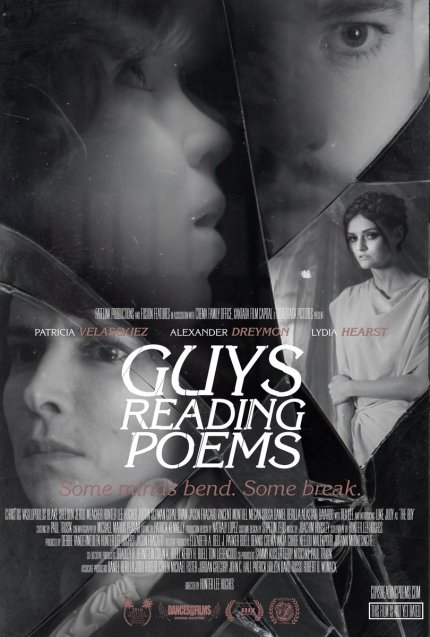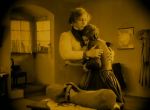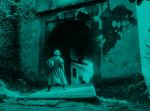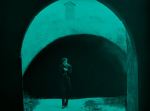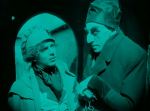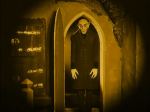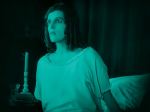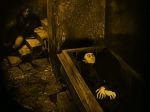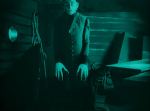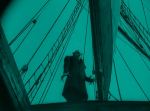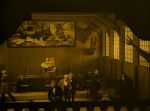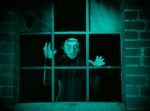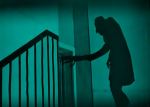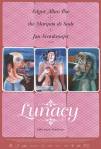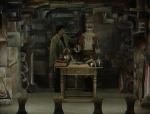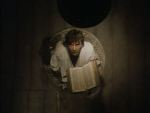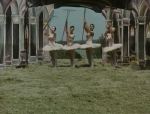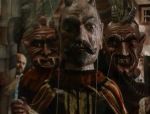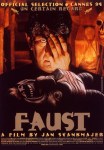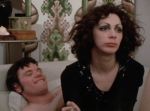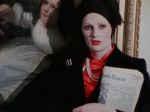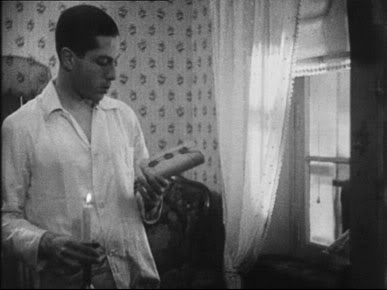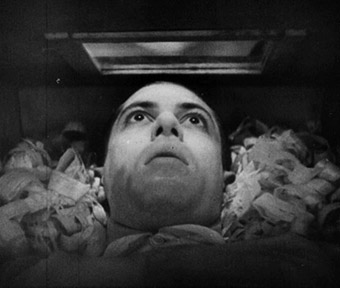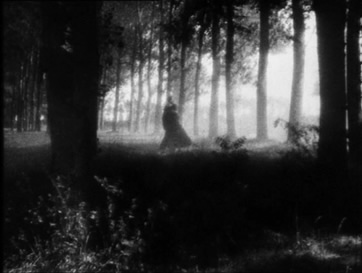
Today’s cinema adventure: Nosferatu, A Symphony of Horror (Nosferatu, eine Symphonie des Grauens), the 1922 German film adaptation of Bram Stoker’s Dracula, directed by the acclaimed and influential F.W. Murnau. An elaborate production, filmed largely on location, it was the first major film to focus on a vampire and has exerted a strong and lasting influence over the 90 years since its release; yet it was almost lost due to the fact that the production studio- Prana Films- never obtained the rights to Stoker’s novel and was sued by his widow, resulting in their declaration of bankruptcy and an order to destroy all copies of the movie. Fortunately, one copy had already been shipped out, and thanks to its survival Nosferatu (as it is now commonly known) was eventually heralded as a true classic, developing a cult following and becoming a cultural icon.
The plot is more or less familiar to anyone who has read or seen Dracula in any of its more “official” versions, but the setting and the names of the characters have been changed, and several new ideas are introduced in addition to the creation of a significantly altered ending. It opens with idyllic scenes of life in the fictional port town of Wisborg; a young man, Thomas Hutter, is being sent to faraway Transylvania by his employer, a real estate agent named Klock, in order to conduct a transaction with the mysterious Count Orlok, who wishes to buy a house in their town. Though his beautiful and virtuous wife, Ellen, has dark forebodings about the trip, Hutter leaves her in the care of friends and enthusiastically embarks on his journey. Once he arrives at Orlok’s ruined castle, however, he begins to suspect that the reclusive count- a thin, ghoulish-looking eccentric who evokes deep fear in the local villagers- may have darker intentions than a simple change of scenery; after the deal is finalized, the young man is horrified to discover that his host is indeed a member of the undead, a powerful vampire who sleeps by day in a coffin under the castle- but the knowledge comes too late, for Hutter finds himself imprisoned in his room, watching helplessly from a window as Orlok loads several coffins full of dirt into a wagon and departs for Wisborg. Fearing for the safety of his home town- and especially of his beloved wife- he manages to escape from the castle and begins to make his way back to Wisborg, hoping he can arrive in time. The count, meanwhile, travels by ship, concealed below deck in one of his coffins; along the way, he victimizes every port town at which they stop, leaving behind rumors of plague. He also preys upon the crew, killing them one by one until the boat arrives in Wisborg, seemingly a ghost vessel inhabited only by rats- brought on board within Orlok’s spare coffins. Believing the rodents have carried the spreading plague to their town, the authorities warn the citizens to remain secluded in their homes, and Orlok, having moved into his new abode and using the supposed epidemic as his cover, begins to feed upon the terrified population. When Hutter finally arrives home, he finds that Ellen, to his relief, is so far unharmed, but she is consumed by melancholy and terrified of the new neighbor who stares at her from his window at night. Though her husband tries to hide the truth from her, she discovers from his books the true nature of the threat, and learning that the vampire can only be destroyed by direct sunlight, she resolves to undertake a dire strategy by which she might lure Count Orlok to his doom.
The screenplay for Nosferatu, which has received much praise for its deliberate, rhythmic pacing and its pervading air of cool melancholy, was authored by Henrik Galeen, an Expressionist writer hired by the film’s producers for his expertise in the dark romantic style they wished to capture. Though the great Murnau is usually given credit for the movie’s eerie mise-en-scène, Galeen’s script was in fact quite detailed in its meticulous, shot-by-shot description; he included specific instructions for each scene, with directions for timing, camera angles and composition, and lighting, even providing sketches for reference in framing shots. The result is a haunting, dream-like exploration of the primal fears hiding in the dark corners of man’s imagination, given form through the persistent folklore that has resisted the rise of science and reason since the days of the Black Death. Though the vampire myth is ancient and universal, its most familiar and lasting incarnation springs from the superstitious tales of Central Europe, where bubonic plague wiped out whole medieval villages and prompted the survivors to imagine other-worldly causes for its indiscriminate and unstoppable devastation- not only vampires, but werewolves and other insidious monsters of the night became the dreaded scapegoats for this seemingly unexplainable onslaught of death, and legends of their continuing existence endured throughout the centuries as a reminder of those dark times. Galeen’s scenario, borrowed as it may have been from Stoker’s then-still-fairly-recent novel, stirs up all of these arcane fears embedded in cultural memory. Indeed, before Orlok ever appears onscreen there are scenes of a werewolf prowling the night (with a striped hyena- a bizarre-looking and fearsome creature that was largely unfamiliar to most 1922 moviegoers- standing in for the supernatural beast), and memories of the ancient plague are clearly tapped by the tale’s conceit of using the threat of just such a rat-borne pestilence as a subterfuge to mask Orlok’s killing sprees; even the vampire’s makeup, with his large, pointed ears and pronounced, close-set fangs, is designed to be rat-like and enhance the correlation between monster and disease. Though Nosferatu is set in the 1830s and was made in the 1920s, as we watch it in the 2010s our subconscious is undeniably returned to the Dark Ages, when the night concealed forces which we could neither fathom, foresee, nor combat, and safety was an illusion that could only be maintained by the light of day.
As for Murnau, even if he was guided extensively by the wishes of the screenwriter, his genius clearly shows through. His meticulously faithful adherence to Galeen’s directives is infused with his own brand of cinematic poetry, creating a striking visual statement that leaves lingering images in the viewer’s mind. His skill at using light and shadow is here used to great advantage, with his particular gift for capturing the almost tactile properties of both helping immeasurably to build the heightened, nightmare reality of the film. Nosferatu, after all, is pure Expressionist cinema- albeit tempered by the sensibilities of gothic romance- and as such is intended to simulate a sort of dream-state, in which the impulses of the unconscious psyche are manifested in outward form; Murnau’s ability to create this hallucinogenic, psychically resonant feel onscreen is largely responsible for its overwhelming success at this objective. Nor should his efforts with the mechanics of storytelling be ignored; he drives his film at precisely the right pace, neither too slowly or too quickly, but with a strong feeling of inexorability that feeds our cumulative sense of dread and pulls us deeper into the narrative. This effect was neither accidental nor accomplished after the fact through editing; the director filmed each scene with precision timing, even using a metronome to guide his actors, and controlled the rhythm and flow of the movie with such a musicality that its subtitle, “A Symphony of Horror,” is not at all hyperbolic.
The film’s other components should be noted, as well, for they all support Murnau’s artistry by building a cohesive visual unity. The director’s remarkable portrayal of light- such a tangible force it is itself almost a character in the drama- is made possible by the luminous work of cinematographer F.A. Wagner- who, amazingly, accomplished the entire shoot (even the extensive location footage) with only a single camera. Contributing immensely to the visual style, which not only makes heavy use of the theatrical, larger-than-life elements of Expressionism but also draws extensively on older, more traditional influences from Germany’s rich and varied artistic heritage, is the set-and-costume design of Albin Grau. His creations- with the help of Murnau and Wagner’s intricate lighting- evoke paintings by the great masters, but they also lend themselves to the edgy avant-garde milieu of the then-present-day; this melding of the familiar with the jarringly strange is yet another way in which Nosferatu derives its power. Grau was one of the film’s producers, and indeed had first conceived the idea of making the movie, inspired by an incident during his service in WWI, when a Serbian farmer told him that his father was a vampire; no doubt haunted by his imaginings of this farmer’s undead patriarch ravaging the countryside at night, he knew it was the sort of irrational dream material that was perfect for expression through film. It might be said that, more than Galeen or even Murnau, Nosferatu was his film; accordingly, his considerable design contributions, infused with the passion of a personal vision, should not be overlooked.
Though it was, of course, a silent film, music was nevertheless intended to play an important role in Nosferatu. Sadly, the original score composed to accompany its screening, written by Hans Edermann, was long thought lost. As a result, there have been numerous alternative scores created over the years, in styles ranging from lush orchestral romanticism to dissonant avant-garde minimalism. The print I watched recently (available on Netflix streaming video) features a score composed in 2000 by the Silent Movie Orchestra, consisting of a fairly contemporary-sounding ensemble utilizing such elements as electronic organ and heavy percussion; personally, I found it highly effective, but obviously it’s a matter of taste. Many feel that the score for a silent movie can only be appropriate if it is created in the style of- and with the instrumentation available in- the era in which the film was made; others have a more flexible preference, and obviously the majority of casual viewers will most likely find such a question immaterial (though I would venture to say that many of those who claim they cannot enjoy silent films are basing their opinion on the experience of seeing one with a generic, woefully inadequate musical accompaniment- the effect of music on this art form cannot be overstated). There are a number of prints available, with different scores to accommodate every taste, so if this aspect of the film is a concern, you would be well-advised to do a little research before choosing which version to watch. The now-reconstructed Edelmann score is featured on Kino’s restored print, which also offers probably the cleanest video quality available today, complete with the original, all-important chromatic tinting to differentiate day from night (in pure black-and-white, as most silent films were commonly shown for decades, time of day becomes a confusing issue); obviously, watching this edition is the best option, if possible; otherwise, there are numerous other versions available for free viewing online- after all, the movie is in the public domain, at least in the United States.
Whatever musical accompaniment you might favor, if you are a serious cinema aficionado, watch Nosferatu you should. Though many other horror films pre-date it, it is unquestionably the first unqualified masterpiece of the genre, from which all subsequent entries have sprung; not only have Galeen’s screenplay and Murnau’s direction spawned thousands of imitators throughout the past century, their film contains the first bona-fide horror icon (with the possible exception of Conrad Veidt’s somnambulistic murderer in The Cabinet of Dr. Caligari) in the form of Count Orlok. As embodied by character actor Max Schreck, the count is a nightmarish figure indeed; a far cry from the darkly romantic charm of Bela Lugosi and other later interpretations of the Dracula character, he is utterly devoid of humanity, spectral, repellant and coldly detached. He famously grows uglier as the film progresses, with fangs and talons seeming to grow larger as he becomes more steeped in bloodshed and death. Like an anthropoid vermin, he moves his spindly frame with a grotesque grace and gazes with dull malevolence through his not-quite lifeless eyes; it’s easy to see why Schreck has been shrouded with mystery in the popular imagination, even being portrayed as a real vampire in the fictional 2000 film about the making of Nosferatu, Shadow of the Vampire. For many years, cinematic legend surrounding the film has wrongly implied his surname was adopted for this role due to its translation into the English word “fright,” but Schreck was indeed his birth name, and he had enjoyed a long and prominent career in German theatre and film prior to being cast as Orlok. He deserves full recognition for his performance, a masterful creation in which he uses his physicality to bring the full essence of this loathsome character to the screen; to attribute his effectiveness solely to savvy casting, though Murnau reportedly picked him for his ugliness alone, is to discount the level of commitment this fine actor brought to the role, helping to make it one of the most definitive and influential screen depictions of a horror character ever filmed- an even more remarkable feat considering that he is actually on screen for a total of less than 10 minutes
The rest of the cast, though many of them have much more screen time, are not quite as unforgettable as Schreck- how could they be? This doesn’t mean their work is inferior, however; all of the players provide vivid portraits of their characters, delivering top-notch performances in the accepted style of the day. Gustav von Wangenheim, a noted theatrical writer/director and performer, and film’s true leading actor, is robust and florid as Hutter, a little over the top, perhaps, but more endearing by far than most of the wooden, stiff-upper lip types offered by later incarnations of the story’s parallel character, Jonathan Harker; the stately and beautiful Greta Schröder adds a touch more weight and dignity than expected to the role of Ellen, making her less the helpless victim than the tragic heroine; and as Knock, the psychically-enslaved real estate broker who serves as the film’s version of Renfield, Alexander Granach gives us a comically exaggerated- but still unsettling- personification of the archetypal greedy old man, here driven to the point of lunacy by the influence of his demonic master and presenting an obvious allegory, in his affiliation with the vampire, for the adulation of wealth and power represented by such figures- which gives Nosferatu a suggestion of sociopolitical commentary, in the sense that Knock becomes a scapegoat for the villagers, who blame and persecute him for the onset of the plague, though- despite his eager participation in the evil that besets them- he is, in reality, just another victim, a symptom of a larger malady that transcends political or economic concerns.
Nosferatu is one of those rare works from the early years of cinema that remains eminently watchable by the average viewer today; there is something about it, perhaps a sense of the dark despair hidden beneath even the brightest promise of happiness and prosperity, which allows it to strike a universal and timeless chord. There are so many haunting and indelible images here: the silhouetted horses fleeing from the marauding werewolf; the spectral coach speeding eerily in stop-motion as it bears Hutter to Orlok’s castle; the ghostly ship gliding inexorably through the night as it delivers the vampire across the waters; the angry mob destroying a scarecrow in its pursuit of Knock; and, of course, every moment of Orlok’s presence, from his first appearance as the sinister driver of the coach to his furtive and decidedly unromantic feeding upon his final victim. The stylized artistry of its presentation, far from making it inaccessible, seems to crystallize it and capture its essence in a form that is instantly familiar. It’s impossible to say, 90 years later, whether the imagery of Murnau’s movie has become integrated into our collective cultural consciousness or if it drew its inspiration from the dark imaginings that were already there; wither way, the effect is the same- Nosferatu is an experience that feels like it is coming from within us, not from without.
http://www.imdb.com/title/tt0013442/
